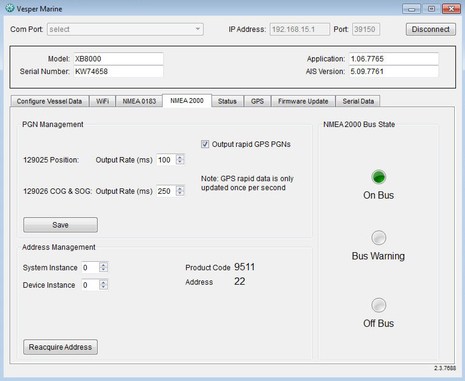

- Vmais configuration and status utility update#
- Vmais configuration and status utility software#
- Vmais configuration and status utility download#
Vesper calls this feature “ Instant Target Acquisition” and both the XB-8000 and Vision can only deliver it to the app, but remember, static target data like vessel names even when powered down. But what you can’t see on the screen is how all those target vessel names (and underlying detail) filled in the moment the app was opened. For instance, that informative AIS Plotter screen above is new.
Vmais configuration and status utility software#
Vesper’s own iPad and iPhone app WatchMate can’t do all the deep configuration that the PC and Mac software can, but it, too, has been improved. Please speak up if you, too, would value that extra feature. I continue to lobby Vesper to build AISdispatcher-type functionality right into the XB and Vision, which would mean that a boat could serve as volunteer station while only running the transponder and perhaps a high power WiFi system like the Rogue Wave or NautiCloud. I only tested WiFi client mode briefly in the lab (because my home WiFi signal is so weak there), but I did confirm that I could even use it to run AISdispatcher and thus send the XB target data to MarineTraffic ( recent Panbo discussion here). The result on a boat like Gizmo is that tablets and phones can use XB data, while also being online and having app access to other onboard devices like a Fusion 700 stereo system.


It’s not just easy to change its access point name (SSID), password, IP address, etc., but it’s also easy to have it join an existing onboard WiFi network (even with a preferable static IP address). Vesper’s utility software gives the XB-8000 the same flexible WiFi management that I experienced with the Vision.
Vmais configuration and status utility update#
I will definitely update both situations as they unfold in the comments section below. The screen above may also reveal a possibly related Vesper GPS date translation glitch that just caught my eye yesterday, but it’s conceivable that both issues are somehow related to my particular test set up. (Surprisingly, though, neither the Garmin 8212 or 741sx displays installed in the lab see the XB-8000 at all, not even on their N2K device lists, but I know for sure that Vesper and Garmin are working together to figure this out. While many GPS receivers offer extra high update rates and/or GLONASS support these days, an AIS transponder that also serves as a GPS has extra value for many boats. The Ray and Simrad GPS diagnostic screens above suggest how thorough the XB’s GPS output is (and I assume Vision output is the same). The Raymarine a77 and e127 (that I’ve been testing LightHouse II on) as well as the Simrad NSS8 MFD and RS35 VHF radio all see the XB-8000 as a valid source of NMEA 2000 GPS (and of course all the MFDs also displayed the AIS target data it’s outputting). As far as I know, though, Vesper is the first to do it, as partially illustrated above, and I saw it work pretty well in the lab. While charting apps and PC programs are often more liberal about GPS validity, it’s always seemed possible that a transponder with a much wider bandwidth N2K connection could provide enough GPS data to be the primary or backup GPS source for the fussier plotters on a network. This is true because many MFDs and chart plotters won’t recognize GPS as valid unless they see some or all of the secondary GPS data messages like “satellites in view,” but the standard NMEA 0183 AIS connection - though called “high speed” at 38,400 baud - barely has enough bandwidth to carry all the AIS target info for a busy area. It’s always been confusing that while Class B AIS transponders are required to have good GPS receivers built in, their NMEA 0183 or 2000 GPS output is often unusable by other devices. Vesper has also significantly improved its NMEA 2000 GPS output. data to an older MFD that didn’t have an N2K port or to a charting program running on the same PC that’s connected to the XB-8000 by USB cable (or via WiFi, as seen in the screen below). For instance, checking those NMEA 0183 boxes above means that I could be sending the translated 2000 wind, depth, etc. Many of the settings aren’t available for any other transponder I’m aware of.
Vmais configuration and status utility download#
Only major N2K message types (PGNs) are supported - wind, depth, speed, heading, log and temperature so far - but the XB (and Vision) have other data gateway and multiplexer features.Ībove is a screen from the much revamped Vesper PC (and Mac) Configuration and Status Utility software that owners can download here. The XB-8000 (or the Vision) can now serve as a NMEA 2000 gateway, translating data on my network into a form that can travel over WiFi and that many apps can understand. That’s quite useful in itself, but note the addition of depth and wind. The SEAiq app above is running on an iPad that’s connected by WiFi to the XB and it’s showing the same GPS and AIS data I saw coming from the Vision last summer. Let’s start with a look at XB-8000 results.


 0 kommentar(er)
0 kommentar(er)
